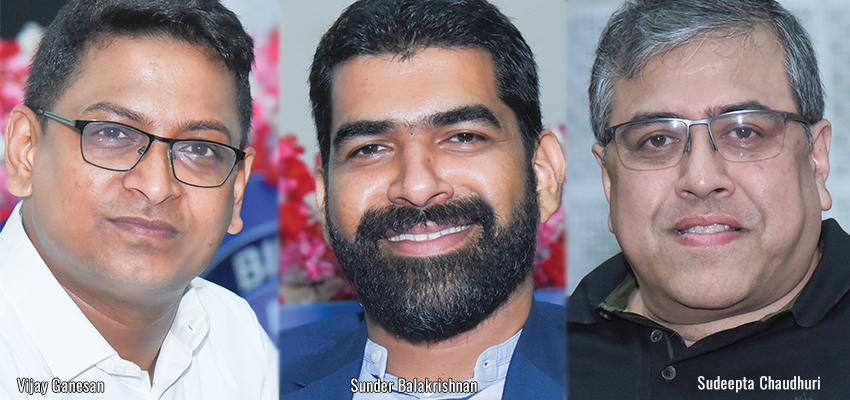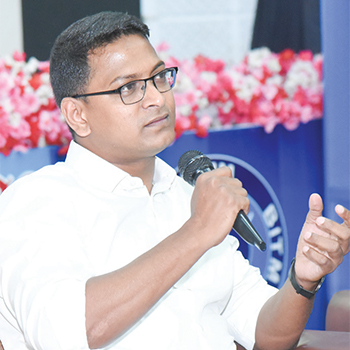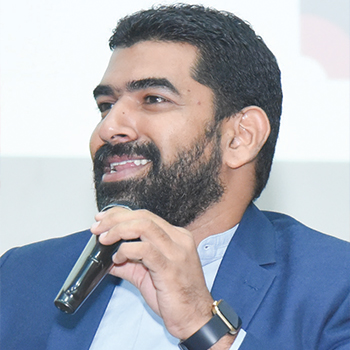Innovating Business Through Tech-Driven Strategies

Innovation in the present climate has become necessary and to stay ahead of the trend, companies must understand that technology is driving this transformation. In a recent Tech Ops Conclave conducted at Sri Balaji University, Pune (SBUP), a panel discussion was held on 'Innovating Business Through Tech-Driven Strategies: Pioneers of Product, Analytics, and Data' wherein industry experts shared their insights on how tech-driven strategies are revolutionising the way they do business. The panellists explored the intersection of technology and business and how technology and data can drive business growth, improve efficiency, and help stay competitive in a rapidly changing world. They also discussed the rise of analytics, artificial intelligence, and the importance of human- centred thinking. Corporate Citizen brings you the excerpts from the session
Panellists
- Sudeepta Chaudhuri, Chief Data Analytics Officer, The Smart Cube
- Sunder Balakrishnan, Director-Supply Chain Analytics, LatentView Analytics
- Vijay Ganesan, Vice President-Consulting, Quantzig
- Sana Ansari, Senior Assistant Professor, Business Analytics, Sri Balaji University, Pune (SBUP) (Session Moderator)
Sana Ansari: How did you (Sudeepta Chaudhuri) start your journey from early career stage to becoming a top leader in the industry?

Sudeepta Chaudhuri: I had an aspiration to join the Indian Army, so I cracked the Indian Military Academy through the combined defence services exam. I was supposed to be an army officer, but luck did not have that way, and I had to move out because of medical reasons. Therefore, I did my Master’s in Economics, specialising in econometrics. After completing the academics, I joined the Tata Group, wherein I built various models and did revenue forecasting—understanding the demand for the Tata vehicles.
In those days around the year 1999-2000, analytics had more to do with some amount of econometric modelling. Gradually, as I got into the space of ACNielsen, I chose to be more on the business domain side, where I worked on customer research and focused on solving business problems by understanding stakeholders' needs, analysing data, and implementing solutions mathematically or statistically.
But, in this journey I was not clear as to whether I wanted to be a retail specialist or CPG specialist. So, I started choosing industries that gave me an opportunity to serve multiple sectors, and companies like Tata and Aditya Birla Group gave me that option. These industries have diverse sectors within their fold, such as cement, telecom, retail and motors. They helped me gain a broad understanding of different domains, which was very critical for my journey.
Q: Were you (Sunder Balakrishnan) also interested in data from the beginning? How did analytics become your calling?
Sunder Balakrishnan: I didn't initially plan to work in data analytics, but my career shaped up organically. Since school, I have been interested in maths and logical thinking—I was more of a left-brain logical thinker than a creative thinker. And, maybe a case of something that my family would only look at my maths scores, so it became a natural part of how I think. I did my engineering in IT, spent a few years in the IT sector, and then did MBA in General Management.
After MBA, I've spent the last 13–14 years in different consulting roles with Infosys, PwC, Course5i, and LatentView. So, data analysis became a crucial tool for solving problems in my work. I remember working on a project related to advanced analytics and neural networks. Four years back or so, I was doing a project with a customer. We started as a problem statement, where the customer asked us to analyse data on agricultural produce procurement. Thus, our team had to do exploratory data analysis.
One of my various customers used to say, "Smell the data"-these are the things that I learnt along the way, and it has stuck with me. I still smell the data every day, every morning I wake up. Every day I try to see that I am at least working on one data sheet, whatever it may be. If not every day, at least in a week, I work hands-on with couple of data sheets and try to extract meaning out of it. This is something I love doing and that meaningfully moves my career ahead. Along the way, I developed a passion for supply chain management, focusing on operations improvement through data applications.
Q: How did you (Vijay Ganesan) start your journey and come into this leadership position in the analytics field?
Vijay Ganesan: I have always enjoyed doing maths, and somehow I felt that this is my thing. But, I'll make it easy for you to understand the field of analytics. There are four things which are slightly different: one, this is an industry where you get to work with a lot of young people. I used to manage a lot of young people, who brought fresh ideas and energy to the job.
The second thing is, with different problems come data trends to solve them. I've also worked across problems like advanced electric cars and traditional banking solutions. So, in that way, you wake up with a different problem every day, and that keeps you running all the time.
Third, in this industry of data-driven facts guide decision-making. I always trusted data, which provided me with the right results and allowed me to present evidence-based solutions to others. Lastly, data analytics is a booming industry, which offers good salaries and career growth, and that's something I like the most about it.
Q: How can creative students work in the analytics industry and how can they contribute to the field?
Sunder Balakrishnan: Engineering has got nothing to do with wanting to be in analytics. When we think about problem-solving or business outcomes by combining four circles in a Venn diagram—business acumen, data, maths and technology-these four circles come together for solving any modern-day problem. To work in analytics, you should be skilled in at least two of these areas.
I lead a team of around 18 members, and at least six of them are non-engineers. Because, I don't need engineering skills, I need more of business acumen. Data is a logical leap, but data also has as much of a creative play. To explain with an example — there was a stretch of about 10 miles of road that was analysed for accident hotspots. There were certain spots on that road where more accidents were happening than normal. Hence, the two agencies working on it started analysing why the accidents are happening and why people are not taking safety measures. After their analysis, they realised that people take precautions on the road based on their perception of risk. Basically, they applied behavioural sciences for road safety. If you feel like you are going to be at risk, that's when you take action. If a road is very smooth, you will realise this while riding a bike or driving a car, you tend to start going faster than what you thought you were. So, they looked at those behaviour patterns.
Now for the solution, the team started drawing white lines on that stretch of road. There was a certain distance between the first white line and the second white line. The third white line has a slightly smaller distance. The fourth has an even smaller distance, the fifth has an even smaller distance, and so on. So, it was a very visual way of telling the driver to slow down, and drivers would slow down. This solution didn't require engineering skills but rather a deep understanding of the problem and creative thinking.
"The data is getting connected much faster and more efficiently. And, there are also engines which are using that information to act in real-time. Now people are able to react to data in a much faster way and in real time"
-Vijay Ganesan
Q: What change do you (Sudeepta Chaudhuri) see in terms of using data, and how has data transformed from the 90s to date?

Sudeepta Chaudhuri: The ability to process data has changed, not the data itself. The same information is being used in various ways due to advancements in data storage, processing, interpretation, and deployment. For instance, we can now easily track viewership numbers through YouTube for global events like Cricket matches. All this information is now easy to get. So, nothing has changed, but our ability to process that and bring insights out of it has made it different.
Another thing to be made a cautionary note over here is that many people are joining this bandwagon without having the necessary knowledge, because they don't want to be left out. However, the basic thing in the data analytics space is your eye to solve a problem, because your problem solving is important in management. Data analysis is about solving real-world problems, and those who can do so are considered data analysts.
In the past, data analysts were not a part of top-level discussions, but now they are. My designation, the fact is, did not exist 20 years back. Designations like chief marketing officer did not exist in the 1930s. But, companies were there in the 70s and 80s, and marketing saw the rise. Today, we are seeing data analytics in a rising phase.
Around 15 years ago, it was said that data analysts or data scientists were going to be the trendy jobs. But, today we are talking about data engineers and they are going to be much trendy than data scientists. However, the field is cyclical, and what is trendy today may change tomorrow. If you, as a person, are in a position to anticipate it and prepare for that, you will be in a glorious phase of your career. The mantra, I will reiterate here is learn, unlearn, relearn—if you are able to do this, then you will be with this phase. Today, it is data science or data engineering; tomorrow it might be completely different.
Being a data scientist or engineer may be in demand today, but new technologies like GenAI may disrupt these roles in the future. Staying adaptable and open to learning is crucial to succeed in this field.
Q: How has the data translated into retail analytics? What is your (Vijay Ganesan) perspective on it?
Vijay Ganesan: The data itself is getting much faster now; there are always four elements to your data: volume, velocity, variety, and veracity. All of it is much faster now. Now with all this evident data which is coming, there is also a goldmine of data, and every company is able to identify the customer and what he or she is looking for, and what you should be serving as information—not even a product, just as information.
So, the data is getting connected much faster and more efficiently. And, there are also engines which are using that information to act in real-time. Now people are able to react to data in a much faster way and in real time. When you log in to a session or on an app, you are able to give a recommendation within that app saying, “Here is what you should be doing”. In that way, things are becoming much more pre-emptive and prescriptive, where data is unlocking so much of the opportunity.
Q: How do you (Vijay Ganesan) strike a balance between data-driven decision-making and intuitive decision-making?
Vijay Ganesan: Today, when we build products with Artificial Intelligence and GenAI solutions, we follow the 80/20 rule. This means that 80 per cent of the product is based on facts, while 20 per cent is open to interpretation. For example, I used to work with an automotive company which evaluated the cars in a way that if you had used your car for five to six years, it would have run for some 20,000 or 30,000 kilometres. Now, with data, we would be able to tell them about the exact worth of the car. However, dealerships often negotiate prices, so our solution provides a range of parameters and a suggested value, which allows them to see the facts behind the valuation. We call this approach as the humanisation of analytics and AI that makes data-driven insights accessible to everyone, regardless of their technical expertise. So, this approach is gaining traction over "black box" solutions, which can be unclear and non-transparent.
"When we think about problem-solving or business outcomes by combining four circles in a Venn diagram—business acumen, data, maths and technology—these four circles come together for solving any modern-day problem. To work in analytics, you should be skilled in at least two of these areas"
-Sunder Balakrishnan
Q: Is it the same in your (Sunder Balakrishnan) supply chain industry?

Sunder Balakrishnan: Absolutely it is. There is a whole field of analytics called augmented analytics; it's been around for at least 3-4 years since the Gartner Report coined this term. In my opinion, it is more applicable in the supply chain. If you think about analytics in marketing versus analytics in sales versus analytics in supply chain, with marketing you have a direct or one-degree separate connection with the consumer, as it influences customer behaviour. With the supply chain, you still need to provide those recommendations and actions, but these are going to be to your internal employees, to a workforce of 30,000 people working in the warehouse, manufacturing, logistics, etc. To nudge these employees to take action, we need to consider their needs and perspectives, as they may not directly benefit from the insights. The supply chain has been around for 200 years in the industry, and while data analysis can optimise routes and forecast demand, it is crucial to prioritise human-centred thinking.
We must communicate insights effectively and collect feedback from employees, acknowledging their expertise and incorporating it into our systems to improve model performance. Respecting the fact that there are people with a lot of knowledge and that knowledge can come back into your system to improve the way your models perform. It is something that we are seeing at least in the supply chain and increasingly in the solutions. It's not about automating and replacing; it is also about augmenting, and this is the philosophy we follow.
Q: How do you (Sudeepta Chaudhuri) balance data-driven decision-making with intuitive decision-making in the telecom industry?

Sudeepta Chaudhuri: Telecom is the only industry that has a direct interaction with you. So rather than focusing on pure play telecom, I would like to touch upon the aspect of how the whole analytics delivers value. For example, if a hammer is given to a child, what will the child do? He will take the hammer and just go hitting around, because he doesn't know the purpose of the hammer.
So, we as analysts often miss the purpose of a tool, and become that kid who is using it anywhere and everywhere—it doesn't work that way. A simple ratio analysis can generate fantastic business results rather than looking for the highest of the algorithms, which are non- deployable in the real world.
If you come up with insights that are deployable on the ground, the value that you will be generating will be greater. You will be more valued because, in the journey, you do not get into technical knowledge and understanding. The world is not only looking for data scientists and data engineers, but the world is also looking for domain expertise. Real-world value comes from understanding problems, generating actionable insights, and implementing solutions with stakeholders.
"The basic thing in the data analytics space is your eye to solve a problem, because your problem solving is important in management. Data analysis is about solving real-world problems, and those who can do so are considered data analysts"
-Sudeepta Chaudhuri
Sunder Balakrishnan: The business outcome part is nailed on it and is the right way to think about it. There's also an interesting dichotomy at play over here. Organisations like OpenAI that has created ChatGPT, the tool, can answer any question, but they may not necessarily solve specific business problems. But in some ways, they didn't think about a business problem when they started building a tool. The problem they tried to solve was just answer anything.

Now as organisations, we are trying to scratch our heads on what's the problem it is really going to solve? Or is it going to truly solve problems or not? This is where the value is going to come from, and that's something you should think about in order to make it deployable and actionable for any business community.
Vijay Ganesan: I will demystify it a little bit. In the last six years, industries like supply chain, marketing or HR have become connected propositions. For example, Google, a service company, now offers physical products like smartphones. Meanwhile, product companies like Hindustan Unilever Ltd. (HUL) are expanding into services. As companies enter new areas, they are copying each other's strategies. Then the aspect of supply chain comes in. When you are trying to go into the digital world, you also have three-day replenishment. You are going to deliver the product at the door of your customer, which means to have a digital strategy, and here the supply chain also needs to step up. So, what we are seeing is a connected proportion where all the data is coming in, and the industry is moving towards a holistic analytics piece. As a result, there is no marketing specialist or supply chain specialist; instead, people who can work across multiple areas are in demand.
For example, college graduates can now create and sell their own branded face cream on Instagram. Larger companies like HUL must adapt quickly to keep up. The second thing is you will see these trends moving from category to category. Turmeric and coconut have been there for decades as food products; now they are coming into beauty trends. Because, people look for cross category and cross-market patterns. And, that’s not an innovation just in your product, service, or supply chain; the change is imminent. People are trying to realise it, and they are trying to roll up their sleeves.